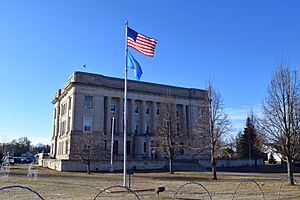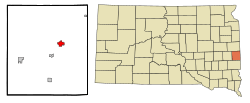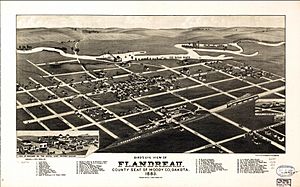Flandreau, South Dakota facts for kids
Quick facts for kids
Flandreau
|
|
|---|---|

Moody County Courthouse
|
|
| Motto(s):
"The Heart Of South Dakota"
|
|

Location in Moody County and the state of South Dakota
|
|
| Country | United States |
| State | South Dakota |
| County | Moody |
| Incorporated | 1902 |
| Area | |
| • Total | 1.93 sq mi (4.99 km2) |
| • Land | 1.86 sq mi (4.81 km2) |
| • Water | 0.07 sq mi (0.17 km2) |
| Elevation | 1,565 ft (477 m) |
| Population
(2020)
|
|
| • Total | 2,372 |
| • Density | 1,275.95/sq mi (492.72/km2) |
| Time zone | UTC−6 (Central (CST)) |
| • Summer (DST) | UTC−5 (CDT) |
| ZIP code |
57028
|
| Area code(s) | 605 |
| FIPS code | 46-21540 |
| GNIS feature ID | 1267391 |
Flandreau /ˈflændruː/ FLAN-droo is a city in and county seat of Moody County, South Dakota, United States. The population was 2,372 at the 2020 census. It was named in honor of Charles Eugene Flandrau, a judge in the territory and state of Minnesota. He is credited with saving the community of New Ulm, Minnesota, from destruction during conflict with the Sioux tribe in 1862.
.....
Contents
Geography
Flandreau is located along the Big Sioux River.
According to the United States Census Bureau, the city has a total area of 1.93 square miles (5.00 km2), of which 1.86 square miles (4.82 km2) is land and 0.07 square miles (0.18 km2) is water.
Climate
| Climate data for Flandreau, South Dakota (1991−2020 normals, extremes 1893−present) | |||||||||||||
|---|---|---|---|---|---|---|---|---|---|---|---|---|---|
| Month | Jan | Feb | Mar | Apr | May | Jun | Jul | Aug | Sep | Oct | Nov | Dec | Year |
| Record high °F (°C) | 64 (18) |
70 (21) |
87 (31) |
94 (34) |
106 (41) |
105 (41) |
112 (44) |
108 (42) |
104 (40) |
94 (34) |
79 (26) |
65 (18) |
112 (44) |
| Mean maximum °F (°C) | 43.1 (6.2) |
49.0 (9.4) |
65.9 (18.8) |
79.5 (26.4) |
86.7 (30.4) |
91.6 (33.1) |
93.0 (33.9) |
91.1 (32.8) |
87.5 (30.8) |
81.5 (27.5) |
63.7 (17.6) |
46.6 (8.1) |
95.4 (35.2) |
| Mean daily maximum °F (°C) | 22.6 (−5.2) |
27.6 (−2.4) |
39.7 (4.3) |
54.4 (12.4) |
67.0 (19.4) |
76.8 (24.9) |
81.3 (27.4) |
79.0 (26.1) |
72.3 (22.4) |
58.2 (14.6) |
41.4 (5.2) |
27.5 (−2.5) |
54.0 (12.2) |
| Daily mean °F (°C) | 13.1 (−10.5) |
17.3 (−8.2) |
29.5 (−1.4) |
42.9 (6.1) |
55.8 (13.2) |
66.4 (19.1) |
70.6 (21.4) |
68.1 (20.1) |
60.0 (15.6) |
46.2 (7.9) |
31.2 (−0.4) |
18.6 (−7.4) |
43.3 (6.3) |
| Mean daily minimum °F (°C) | 3.5 (−15.8) |
7.0 (−13.9) |
19.3 (−7.1) |
31.4 (−0.3) |
44.7 (7.1) |
56.1 (13.4) |
59.9 (15.5) |
57.2 (14.0) |
47.8 (8.8) |
34.2 (1.2) |
21.1 (−6.1) |
9.6 (−12.4) |
32.7 (0.4) |
| Mean minimum °F (°C) | −20.1 (−28.9) |
−14.3 (−25.7) |
−4.9 (−20.5) |
17.1 (−8.3) |
30.6 (−0.8) |
44.0 (6.7) |
48.6 (9.2) |
45.6 (7.6) |
32.3 (0.2) |
18.3 (−7.6) |
2.3 (−16.5) |
−13.0 (−25.0) |
−23.6 (−30.9) |
| Record low °F (°C) | −40 (−40) |
−38 (−39) |
−24 (−31) |
−2 (−19) |
16 (−9) |
29 (−2) |
35 (2) |
32 (0) |
15 (−9) |
−12 (−24) |
−20 (−29) |
−35 (−37) |
−40 (−40) |
| Average precipitation inches (mm) | 0.54 (14) |
0.76 (19) |
1.32 (34) |
2.67 (68) |
4.12 (105) |
4.53 (115) |
3.81 (97) |
3.60 (91) |
3.07 (78) |
2.21 (56) |
1.01 (26) |
0.85 (22) |
28.49 (724) |
| Average snowfall inches (cm) | 5.8 (15) |
8.2 (21) |
6.2 (16) |
4.8 (12) |
0.1 (0.25) |
0.0 (0.0) |
0.0 (0.0) |
0.0 (0.0) |
0.0 (0.0) |
1.2 (3.0) |
5.6 (14) |
8.5 (22) |
40.4 (103) |
| Average precipitation days (≥ 0.01 in) | 5.4 | 5.6 | 5.9 | 7.9 | 10.0 | 9.8 | 7.5 | 7.1 | 6.3 | 5.9 | 4.5 | 5.7 | 81.6 |
| Average snowy days (≥ 0.1 in) | 4.9 | 5.0 | 3.1 | 2.0 | 0.1 | 0.0 | 0.0 | 0.0 | 0.0 | 0.9 | 2.5 | 5.1 | 23.6 |
| Source: NOAA | |||||||||||||
Demographics
| Historical population | |||
|---|---|---|---|
| Census | Pop. | %± | |
| 1880 | 471 | — | |
| 1890 | 569 | 20.8% | |
| 1900 | 1,244 | 118.6% | |
| 1910 | 1,484 | 19.3% | |
| 1920 | 1,929 | 30.0% | |
| 1930 | 1,934 | 0.3% | |
| 1940 | 2,212 | 14.4% | |
| 1950 | 2,193 | −0.9% | |
| 1960 | 2,129 | −2.9% | |
| 1970 | 2,027 | −4.8% | |
| 1980 | 2,114 | 4.3% | |
| 1990 | 2,311 | 9.3% | |
| 2000 | 2,376 | 2.8% | |
| 2010 | 2,341 | −1.5% | |
| 2020 | 2,372 | 1.3% | |
| U.S. Decennial Census | |||
2010 census
As of the census of 2010, there were 2,341 people, 973 households, and 583 families living in the city. The population density was 1,258.6 inhabitants per square mile (485.9/km2). There were 1,091 housing units at an average density of 586.6 per square mile (226.5/km2). The racial makeup of the city was 64.2% White, 0.5% African American, 27.7% Native American, 2.3% Asian, 1.5% from other races, and 3.8% from two or more races. Hispanic or Latino of any race were 3.5% of the population.
There were 973 households, of which 29.4% had children under the age of 18 living with them, 39.6% were married couples living together, 12.8% had a female householder with no husband present, 7.5% had a male householder with no wife present, and 40.1% were non-families. 34.5% of all households were made up of individuals, and 15.8% had someone living alone who was 65 years of age or older. The average household size was 2.35 and the average family size was 3.00.
The median age in the city was 38.4 years. 25.9% of residents were under the age of 18; 8.2% were between the ages of 18 and 24; 22.3% were from 25 to 44; 25.1% were from 45 to 64; and 18.6% were 65 years of age or older. The gender makeup of the city was 47.3% male and 52.7% female.
Early history
The British established a Hudson's Bay Company trading post in 1763 in this area. Present-day Flandreau developed near there, with people attracted to the community because of trading business.
The town of Flandreau was originally settled in 1857, and named for U.S. Indian Agent Charles E. Flandrau. (In the early years, it was sometimes spelled as 'Flandrau'.) Like other settlements in the region, it was abandoned within a year, as a result of threatening activities of the Yankton Sioux during the Indian Wars. They were trying to expel European Americans from their territory.
In 1869, following the American Civil War, the area was resettled by twenty-five families of Christianized Sioux from the Santee reservation. White settlement resumed in 1872. When Moody County was organized in 1873, Flandreau was designated as the county seat.
Richard F. Pettigrew of Sioux Falls, South Dakota, a relative of Pettigrew settlers in Flandreau, promoted establishing an Indian School at Flandreau as part of what was his successful 1889 campaign in the state legislature to be elected for the U.S. Senate. The federal government authorized a school here, and what was first known as the Riggs Institute was opened in 1892. The Bureau of Indian Affairs took over a former Presbyterian Church mission school for the facility.
It has been known as the Flandreau Indian School, an off-reservation Indian boarding school operated by the Bureau of Indian Education (BIE) (an agency established in 2006).
Landmarks
The Flandreau Indian Reservation of the Santee Sioux is in the area.
Education
Flandreau School District 50-3 is the local public school district operated by the state.
Flandreau Indian School is in the area.
Notable people
- Gene Amdahl (1922-2015), computer architect known for Amdahl's Law
- Dell L. Dailey, American military officer
- Roger W. Hunt (1938-2018), South Dakota legislator
- Bill Janklow (1939-2012), politician, South Dakota Attorney General, 4-term Governor, and 1-term member of US House of Representatives
See also
 In Spanish: Flandreau (Dakota del Sur) para niños
In Spanish: Flandreau (Dakota del Sur) para niños


